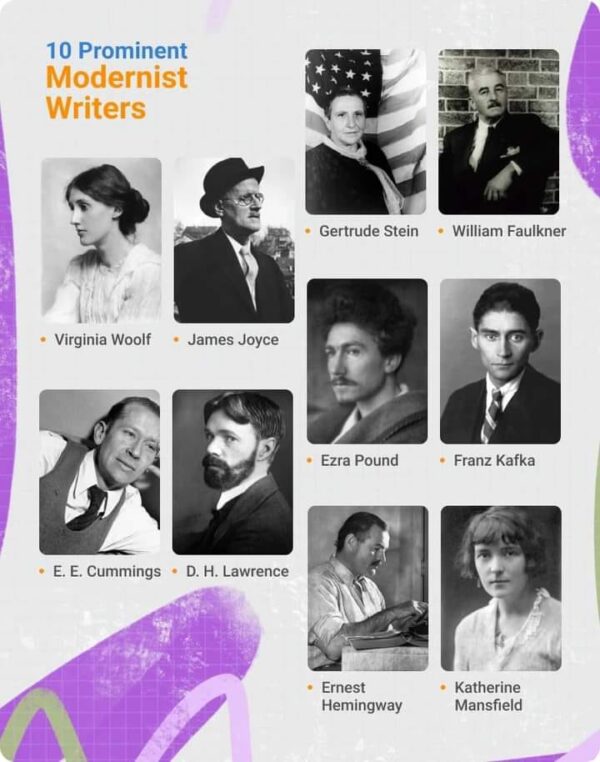The Modern Age of English literature

The Modern Age of English literature, spanning roughly from the late 19th century to the mid-20th century, saw the emergence of many influential writers and poets who shaped the literary landscape with their innovative styles and themes. Here’s a look at some of the key figures:
Novelists:
1. James Joyce (1882–1941)
Notable Works: Ulysses (1922), A Portrait of the Artist as a Young Man (1916), Dubliners (1914)
Contribution: Joyce revolutionized the novel with his use of stream of consciousness and complex narrative structures.
2. Virginia Woolf (1882–1941)
Notable Works: Mrs. Dalloway (1925), To the Lighthouse (1927), Orlando (1928)
Contribution: Woolf is known for her exploration of the inner lives of characters and her experimental approach to narrative and time.
3. D.H. Lawrence (1885–1930)
Notable Works: Sons and Lovers (1913), Women in Love (1920), Lady Chatterley’s Lover (1928)
Contribution: Lawrence’s work often focused on the physical and psychological aspects of human relationships, challenging social norms.
4. William Faulkner (1897–1962)
Notable Works: The Sound and the Fury (1929), As I Lay Dying (1930), Light in August (1932)
Contribution: Faulkner is known for his complex narrative techniques and deep exploration of the human condition, particularly in the American South.
5. Joseph Conrad (1857–1924)
Notable Works: Heart of Darkness (1899), Lord Jim (1900), Nostromo (1904)
Contribution: Conrad’s novels often explore themes of imperialism, human psychology, and moral ambiguity.
6. F. Scott Fitzgerald (1896–1940)
Notable Works: The Great Gatsby (1925), Tender is the Night (1934)
Contribution: Fitzgerald captured the disillusionment of the American Dream and the excesses of the Jazz Age.
Poets:
1. T.S. Eliot (1888–1965)
Notable Works: The Waste Land (1922), The Love Song of J. Alfred Prufrock (1915), Four Quartets (1943)
Contribution: Eliot’s poetry is marked by its fragmentation, allusiveness, and exploration of modern despair and disillusionment.
2. W.B. Yeats (1865–1939)
Notable Works: The Second Coming (1919), Sailing to Byzantium (1928)
Contribution: Yeats’s work often combined Irish mythology with modern themes, reflecting his deep engagement with both his cultural heritage and contemporary issues.
3. Ezra Pound (1885–1972)
Notable Works: The Cantos (1917–1962), Hugh Selwyn Mauberley (1920)
Contribution: Pound was a leading figure in the Modernist movement, known for his advocacy of “make it new” and his influence on other poets, including Eliot.
4. W.H. Auden (1907–1973)
Notable Works: September 1, 1939 (1939), The Shield of Achilles (1955)
Contribution: Auden’s poetry often addressed political and social issues, blending traditional forms with modern concerns.
5. Robert Frost (1874–1963)
Notable Works: The Road Not Taken (1916), Stopping by Woods on a Snowy Evening (1923)
Contribution: Though often associated with traditional verse forms and rural themes, Frost’s work frequently delved into complex psychological and philosophical issues.
6. Dylan Thomas (1914–1953)
Notable Works: Do Not Go Gentle into That Good Night (1951), Under Milk Wood (1954)
Contribution: Thomas is known for his lyrical intensity and exploration of life, death, and the human experience.
Dramatists:
1. Samuel Beckett (1906–1989)
Notable Works: Waiting for Godot (1953), Endgame (1957)
Contribution: Beckett’s plays are often associated with the Theatre of the Absurd, reflecting existential themes and a minimalist approach.
2. Tennessee Williams (1911–1983)
Notable Works: A Streetcar Named Desire (1947), The Glass Menagerie (1944)
Contribution: Williams’ plays often focused on the complexities of human relationships and the struggles of individuals in a changing society.
3. Eugene O’Neill (1888–1953)
Notable Works: Long Day’s Journey Into Night (1956), The Iceman Cometh (1946)
Contribution: O’Neill is considered one of the greatest American playwrights, known for his tragic themes and deep character studies.
These writers and poets were at the forefront of the Modernist movement, each contributing to the era’s distinctive break from traditional forms and the exploration of new, often challenging, literary techniques and themes.